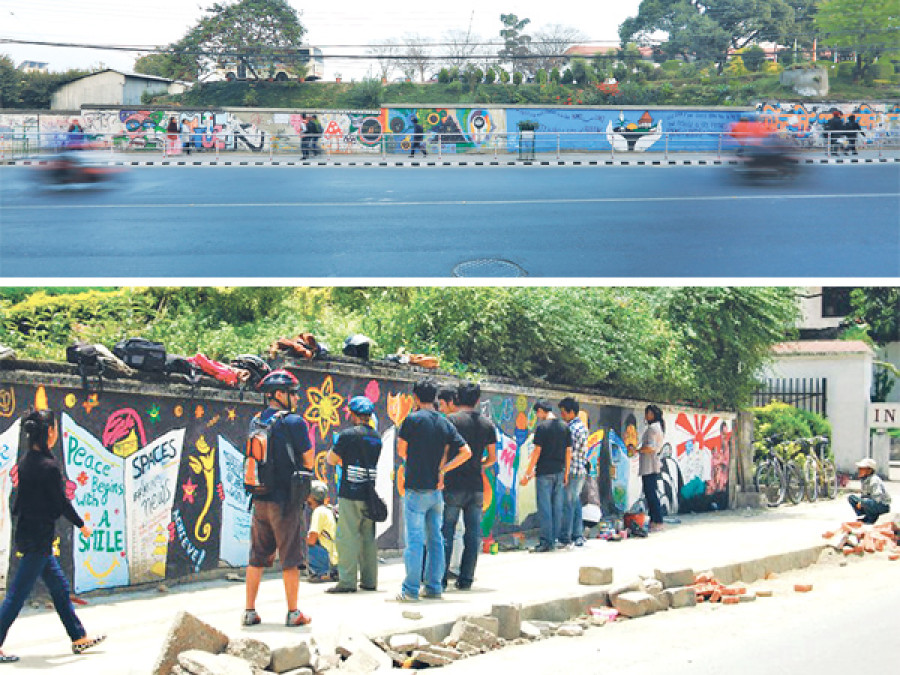The tongue-in-cheek war for public space between artists and political activists rages on at Hotel Himalaya’s boundary wall at Kupondole
If you’ve travelled on the main road in Kupondole, you’ve probably noticed the colourful wall in front of Hotel Himalaya, right where the perpetual line for petrol begins. Currently adorned with wall paintings and positive messages about community, the wall acts as a massive bulletin board for whoever is willing to paint something on it. A close inspection reveals layer upon layer of paint, each one with a story. The most recent addition to the wall is a friendly mural of a panda bear, but the use of this wall as an outdoor public art gallery is a fairly new phenomenon.
For decades the wall spaces in Kathmandu had been the exclusive domain of political activists. These various groups would use the walls to post handbills and write slogans promoting rallies and ideologies. It was the same for the Kupondole wall for many years. As the executive manager of the Hotel Himalaya, Rabindra Tandukar, explained, “Back then the walls were painted in the middle of the night, without permission from the hotel. We would then paint over them with a fresh coat of white, only to have new slogans painted in the following weeks.” This began to shift only in 2011 when one New York-based artist Bruno Levy arrived and began painting a few selected walls in the city. His work inspired a young generation of artists in Kathmandu to reconsider the use of public spaces and to add some colour to the city.
It was but a few months after Levy had finished his art work, one artist, Kailash K Shrestha, gathered a group of friends and fellow artists to paint a wall mural of their own. “We really wanted to communicate some constructive and positive messages,” said Kailash, “because at the time people were so frustrated with the problems surrounding the constitution”. He insisted their work had no personal or political agenda, and that they were only interested in transforming the walls. The artists originally sought permission from the government to paint around Ratna Park, but finding them uncooperative, they approached Hotel Himalaya, who were happy to help.
Amid political uncertainty and social tension, on the day that was supposed to mark a new constitution, the artists pooled together their resources and took to the wall. “Most people were shouting,” explained Kailash, “But we were shouting through the wall—it was our weapon.”
This first street art made quite an impression on the local community and online, and remained up for two months before political propaganda again took over the public wall. This time, however, the font was massive and stretched across the whole wall. It was as if the political sloganeers had been inspired by the artists. Their work now mimicked the scale of the art they were painting over.
The struggle to monopolise public spaces is nothing new. Political scientist Hari Sharma recalled the student protests of 1978, when arguments over who could paint on what walls sometimes even turned violent. “During our pro-democracy demonstrations, there were serious conflicts between student groups over the control of public spaces. In some cases, actual fights would occur.” The current tension, then, is playful in comparison.
Kailash and his artists again took to the wall, painting over the fresh slogans with new art. This new work, however, lasted only a week before the sloganeers struck back. As the weeks went by, the street art in Kathmandu began to attract interest and gained momentum. Through projects like Artudio and Kolor Kathmandu, an entire community of artists emerged and they set out to beautify the city with their self-expression and to communicate a positive message to the wider public.
The wall as it currently stands has been free of political slogans since it was rebuilt after the quake, leading some artists to think that the battle between art and politics, on this wall at least, has been won. While the efforts to paint over political propaganda may not have been politically motivated, one cannot deny the political implications. By depoliticising public spaces, the artists are resisting the bombardment of propaganda and encouraging others to do the same.
Yet, if street art has a political function, then what distinguishes it from propaganda? On this matter, Bruno Levy, the man attributed to bringing street art to Kathmandu suggested that the distinction between art and propaganda is not always clear. “Art can be another form of propaganda,” wrote Levy, “But I believe the message of most street artists is less malicious. If it has a strong message, even a political one, it is usually from the individual perspective of the artist. It is a dialogue between the artist and their audience. Street art does not try to manipulate the viewer with a specific agenda for a larger political party. What does the artist gain in telling his viewers to wake up? Will they vote for him in the next elections? I believe the intention is the main difference.”
That public spaces should be constantly changing, and not in the sole control of a political party, or even an artist group, suggests that public discourse is exactly as they should be. Public discourse and free expression strengthen a democracy, and both the artists and the slogan painters contribute in important ways. If democracy is ultimately a battle of public opinion, then things like pamphlets, posters and wall paintings offer a means of communication that is accessible to those who can’t afford the wider channels of mass communication like radio and television. While public spaces offer political parties an opportunity to communicate their messages to a wide range of people, it can offer unknown artists a chance to have their work seen by a larger audience, and even undermines the prevailing dependency placed on galleries for artists to showcase their work. In some sense, street art is unique, in that is removes the museum, or the gallery and brings the work right to the people.
Still, if it weren’t for the political parties painting over the wall murals, we might find ourselves staring at the same images in front of Hotel Himalaya, year after year. So for that reason, I hope the sloganeers continue to paint over the street art, if only to ensure that walls of this public art gallery are being constantly updated.

